What are the best sweeteners for the keto diet? Check out this comprehensive guide to baking with sugar substitutes, and learn how to get the taste and texture you crave!
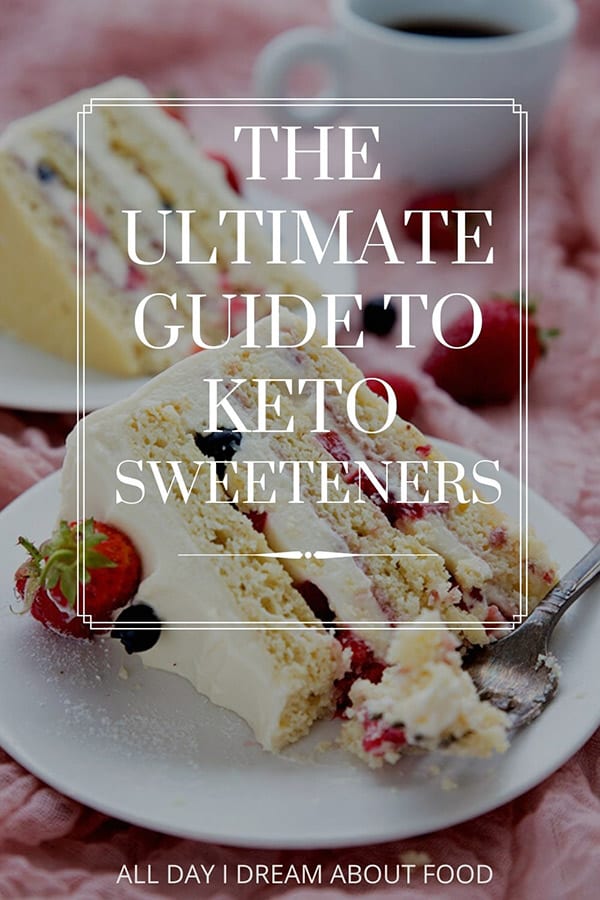
Today, my keto friends, I am imparting some of my vital knowledge and deep wisdom about using keto sweeteners. We will discuss all of their pros and cons, and how they affect the outcome of your keto desserts.
In advance of the holiday baking season, I figured you could put this information to good use. Because if you’re anything like me, you like to get an early jump on your keto holiday cookies!
This is actually an abridged version of the in-depth keto sweetener section in my book, The Ultimate Guide to Keto Baking. I think you will find it very informative.

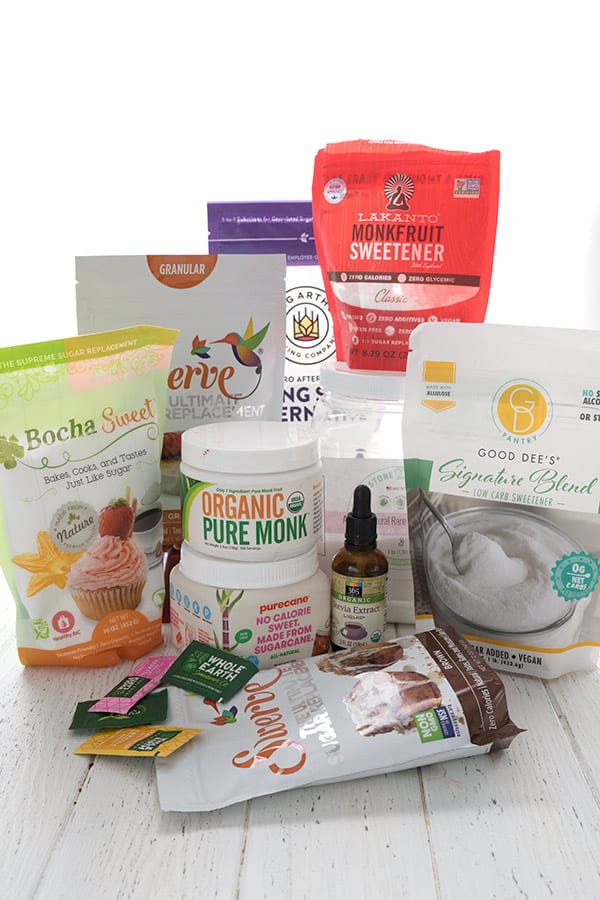
What is the best keto sweetener?
I’m sorry, I simply cannot answer that for you.
I’m not being willful or stubborn, or deliberately withholding information. It’s simply that there is no such thing. Yes, you read that right – there is no such thing as the best keto sweetener.
Here’s why: Everyone experiences these sugar substitutes differently. It’s almost as individual as the individual themselves.
- Some people experience an unpleasant aftertaste with one and not another.
- Some people suffer from GI issues or headaches when consuming certain sweeteners.
- Some people see a blood sugar rise when other people do not.
- Some people may even experience an allergic reaction to certain sweeteners.
With the sugar substitutes market constantly expanding and changing, it’s much more about finding what sweeteners work best FOR YOU.
What are the best sweeteners for keto baking?
Ah, now we’re on to something. This is my territory and one that I have researched extensively. I have experimented with a wide array of sugar substitutes and I can tell you straight up that none of them behaves exactly like sugar.
They all have very different properties and the sweetener(s) you choose will impact the outcome of your recipes. The trick is to understand their different attributes and use them to advantage.
Consider the final product before choosing your sugar substitutes. What are you trying to make? What consistency are you trying to achieve? Do you want it crisp or soft? Chewy or cakey? Should it be gooey or firm?
Most of the popular brands on the market are actually blends of two or more keto sweeteners. For simplicity’s sake, I am going to break them down into their main ingredients.
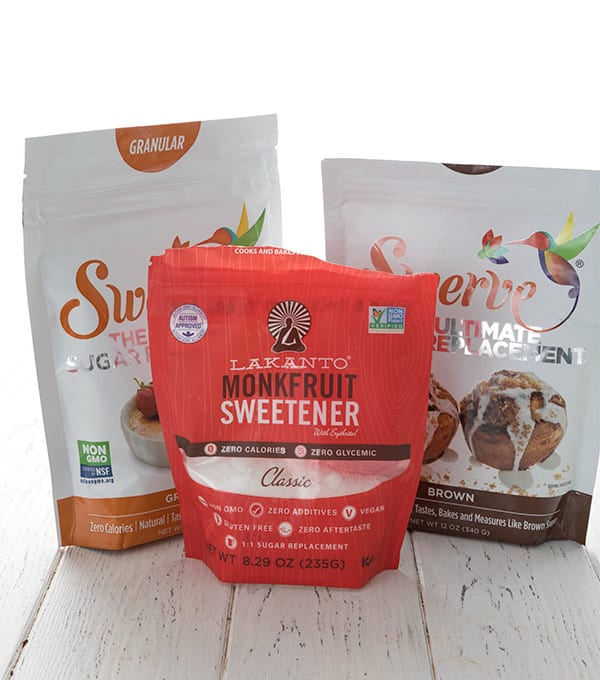
Erythritol
What is it?
Erythritol is a sugar alcohol (polyol) that is naturally present in some fruits and fermented foods. For mass production, it is made by fermenting a glucose syrup with enzymes.
It is unique among sugar alcohols in that it has zero carb impact. Our bodies simply do not recognize it as a carb so it does not impact blood sugar at all. And unlike many sugar alcohols, it does not cause gastrointestinal issues for most people.
How does it work?
Similar to sugar:
– Erythritol mimics sugar in its crystalline structure, so it helps whip air into butter and egg whites.
– It also browns and crisps up nicely and it can even be coaxed into caramelizing.
Differs from sugar:
– It’s only 70% as sweet as sugar, which is why most brands combine it with other sweeteners, to make it measure cup for cup.
– It’s non-hygroscopic, meaning that unlike sugar, it does not attract or hold onto moisture, which can cause baked goods to be dry and crumbly if they don’t have enough fat.
– It can re-crystallize as it cools, particularly in liquid applications like sauces, custards, and ice cream.
– Some people experience a mouth-cooling sensation, similar to sucking on a mint. Not everyone experiences this, and often mixing it with other sweeteners eliminates this sensation.
Major Brand Names: Swerve, Lakanto (this is mostly erythritol… do not be fooled by the fact that it calls itself a “monk fruit sweetener”), So Nourished, ZSweet.
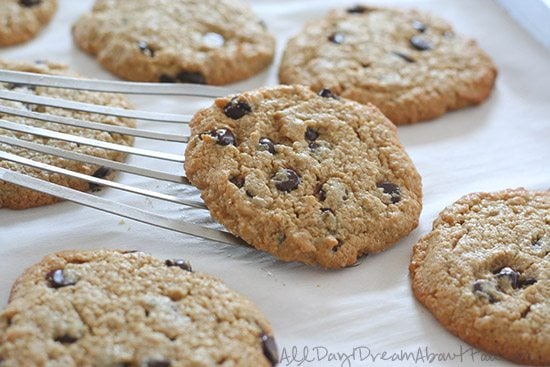
Xylitol
What is it?
Xylitol is also a sugar alcohol found in some fruits and vegetables, as well as in wood and corn. It is usually manufactured commercially from corn or birch trees.
Some, but not all, xylitol is absorbed by the intestines into the bloodstream. This means it can cause some gastrointestinal discomfort when consumed in large amounts. It can also have an impact on blood sugar.
WARNING! The biggest issue with xylitol is that it is highly toxic to dogs.
How does it work?
Similar to sugar:
– It has a crystalline structure so it can whip air bubbles into butter and egg whites. It’s also as sweet as sugar.
– It’s more hygroscopic than erythritol so it attracts moisture and it doesn’t re-crystallize as it cools. Xylitol is great for ice creams and sauces to keep them soft.
Differs from sugar:
– Xylitol doesn’t caramelize or crisp up very well. This can cause problems for baked goods that need a crisp texture, like many keto cookies. They will turn out much more cakey and soft if you use xylitol.
– Definitely do NOT use for meringue, as it will stay gooey and soft, and won’t come off the parchment paper.
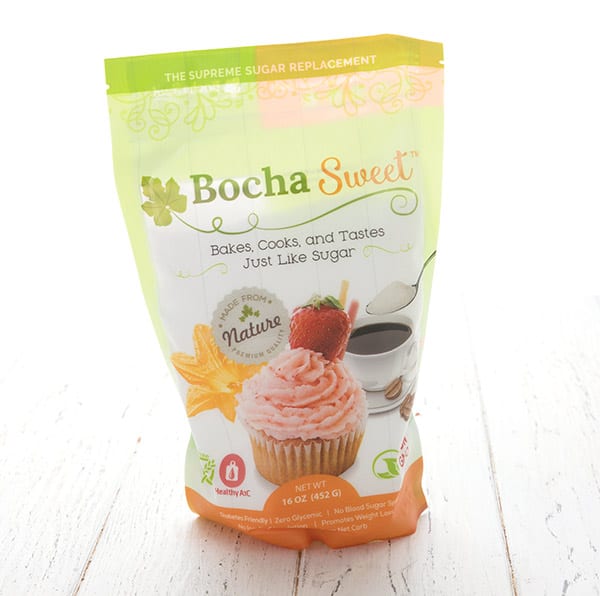
BochaSweet
What is it?
BochaSweet is the brand name of a unique sweetener derived from the kabocha squash, a type of winter squash also know as Japanese pumpkin.
Like erythritol, it seems to have little to no impact on most people’s blood sugar. But like xylitol, it can cause some gastrointestinal upset when consumed in large quantities.
In many ways, BochaSweet functions a lot like xylitol (they are both pentose sweeteners), but it does not appear to be toxic to household pets.
How does it work?
Similar to sugar:
– BochaSweet is as sweet as sugar and so can be used as a cup-for-cup replacement, without an apparent aftertaste.
– It is more hygroscopic and doesn’t re-crystallize so it’s great in sauces, custards, and ice creams. (I have started using it in combination with Swerve in all of my keto ice cream… they stay scoopable even straight from the freezer!).
Differs from sugar:
– Just like xylitol, BochaSweet will not crisp up or brown very well. Cookies end up soft and cakey, and meringues are so gooey that they won’t come off the paper.
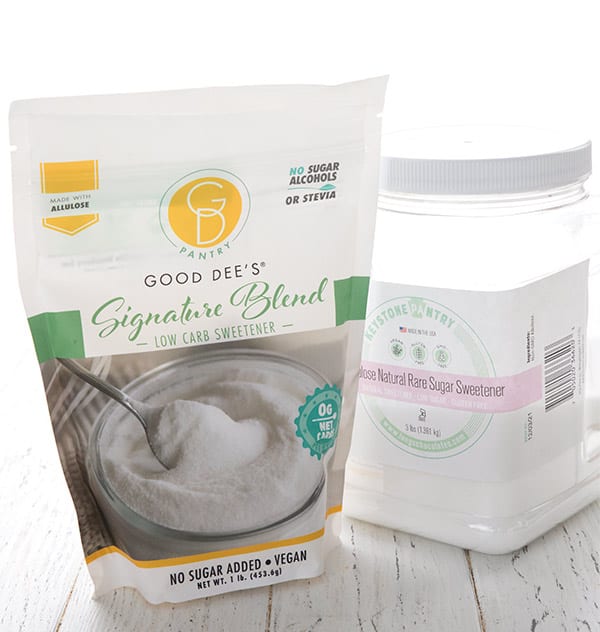
Allulose
What is it?
Allulose is a relative newcomer on the sugar alternative scene and has become incredibly popular. It is a monosaccharide, which means it really is a “sugar”, but one that our bodies don’t treat like a sugar or a carb. It is largely excreted without ever affecting blood glucose levels.
However, I caution you from personal experience that large amounts can cause serious GI distress. Many people don’t seem to suffer from this, but some of us do and it’s…not fun.
So it’s worth testing on yourself in small amounts and building up from there.
How does it work?
Similar to sugar:
– Allulose caramelizes nicely and tends to be hygroscopic, keeping sauces and ice creams soft, and baked goods tender.
Differs from sugar:
– Allulose is only 70% as sweet, which means you need more to sweeten your desserts.
– While it caramelizes well, it doesn’t crisp up well and baked goods tend to be soft and cakey. Even just a little allulose, in combination with other sweeteners, can prevent your cookies from becoming crisp.
– It can over-brown the outside of baked goods, especially the parts that are touching the sides of the pan. Cakes can have a dark, almost burnt appearance, although they aren’t over-cooked.
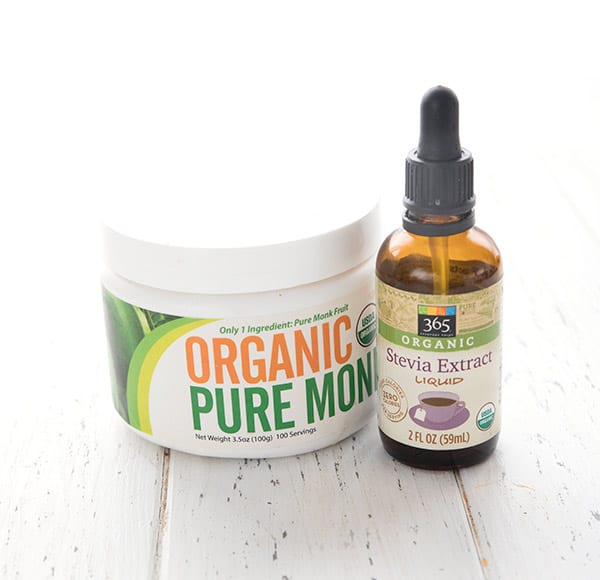
Stevia and Monk Fruit
I am lumping these two together because they have many similar properties and behave much the same way.
What are they?
Both stevia and monkfruit are naturally derived, plant-based sweeteners that are hundreds of times sweeter than sugar. Because they are extremely concentrated, a tiny amount can sweeten a whole recipe.
While that may sound like a good thing, it can have major implications for your keto baked goods. Read on…
How do they work?
Concentrated sweeteners like these have no “bulk” – they have little in the way of weight or volume so they don’t add much to your recipe other than sweetness. They can’t contribute anything to texture or consistency, and they don’t caramelize, crisp, or brown your baked goods.
Bulk is an important factor in anything from cupcakes to frosting. Substituting a non-bulk sweetener means your keto treats may not rise properly, may be more fragile, and may not set properly.
“Monk fruit sweetener”
Please be aware that many brands that bill themselves as “monk fruit sweetener” are actually mostly erythritol. The main ingredient is erythritol, with a little monk fruit to make it sweeter. This means that the sweetener will behave mostly like erythritol.
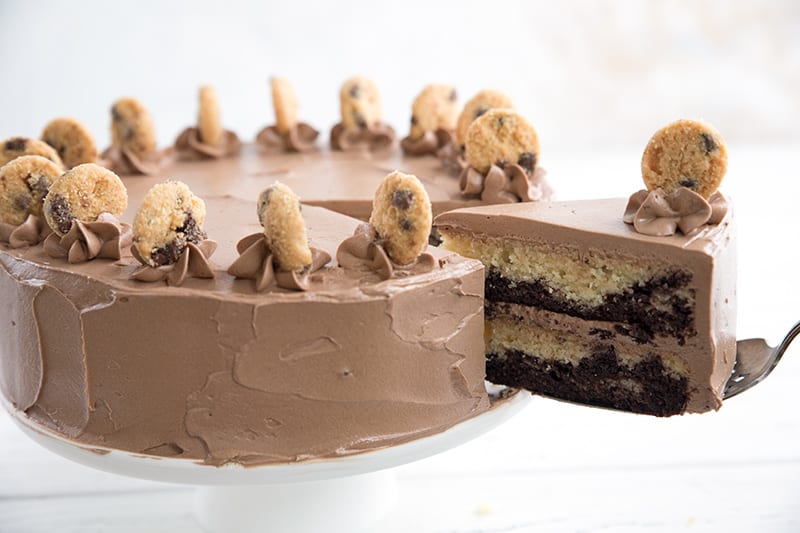
How to use sugar substitutes
I’ve thrown a ton of information at you and I know it’s hard to digest it all. I do this for a living and still I have times when a certain sweetener doesn’t behave the way I think it should. But here’s a quick cheat sheet on what to use when:
Want crisp keto cookies? Use erythritol based sweeteners like Swerve, Lakanto, or So Nourished. Other options will make your cookies soft and cakey. I highly recommend Swerve Brown for the best brown sugar substitute for cookies!
Making a keto cake recipe? Use any sweetener that has bulk (erythritol, BochaSweet, xylitol or allulose), but do be forewarned that some are not quite as sweet as sugar and you may need more of them.
Making a keto frosting? You need a bulk powdered sweetener to give your frosting structure. Erythritol, xylitol, and BochaSweet all have confectioners (powdered) versions. Allulose may as well but I am unsure of brands.
Want a gooey consistency? Try using BochaSweet or allulose, or combine it with another erythritol based sweetener. This combo is perfect for things like keto caramel sauce or my keto pecan pie.
Want keto ice cream that stays scoopable for days? My recommendation is half Swerve and half BochaSweet or allulose. Using only erythritol based sweeteners makes your ice cream rock hard, and all BochaSweet makes it too soft (it stays like soft serve!).
Just trying to sweeten your coffee? Use whatever you like best. They all work well if you don’t need a certain consistency so this is a matter of personal preference.
Still have questions?
Leave a comment and I will do my best to answer!
Adding to the confusion is that many brands on the market are blends of the keto sweeteners I outlined above. Blending sugar substitutes can maximize their sweetness and reduce potential aftertastes.
But I’ve tried such a wide array of sweeteners, I have a good idea of how most of them work. I can also take an educated guess based on the ingredients list. So drop me a line and I will give you all the information I can.

Free Bonus: Secrets to Keto Baking!
Sign up for your favorite recipes delivered straight to your inbox plus get our FREE bonus: Secrets to Keto Baking!

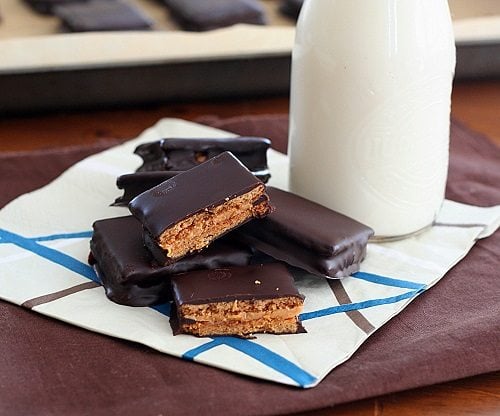
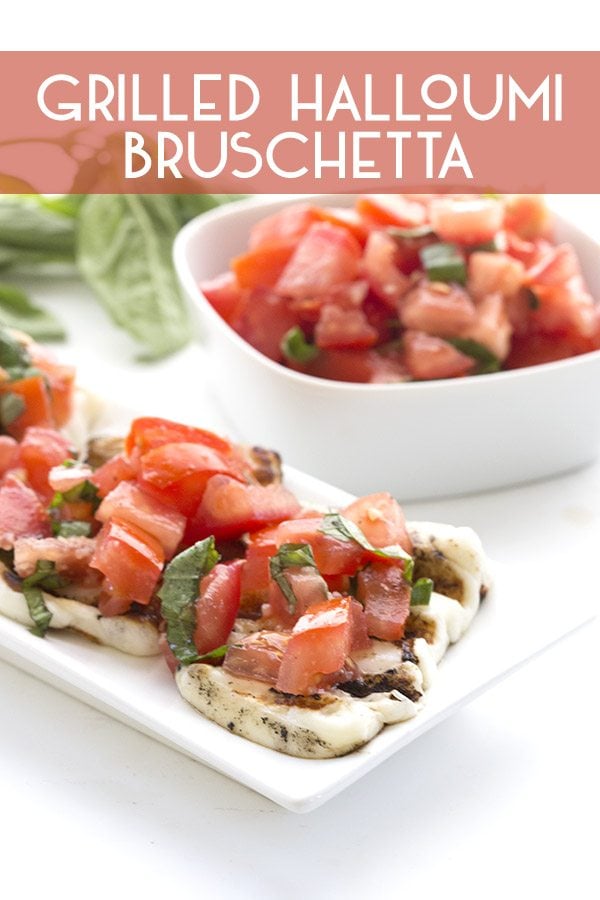
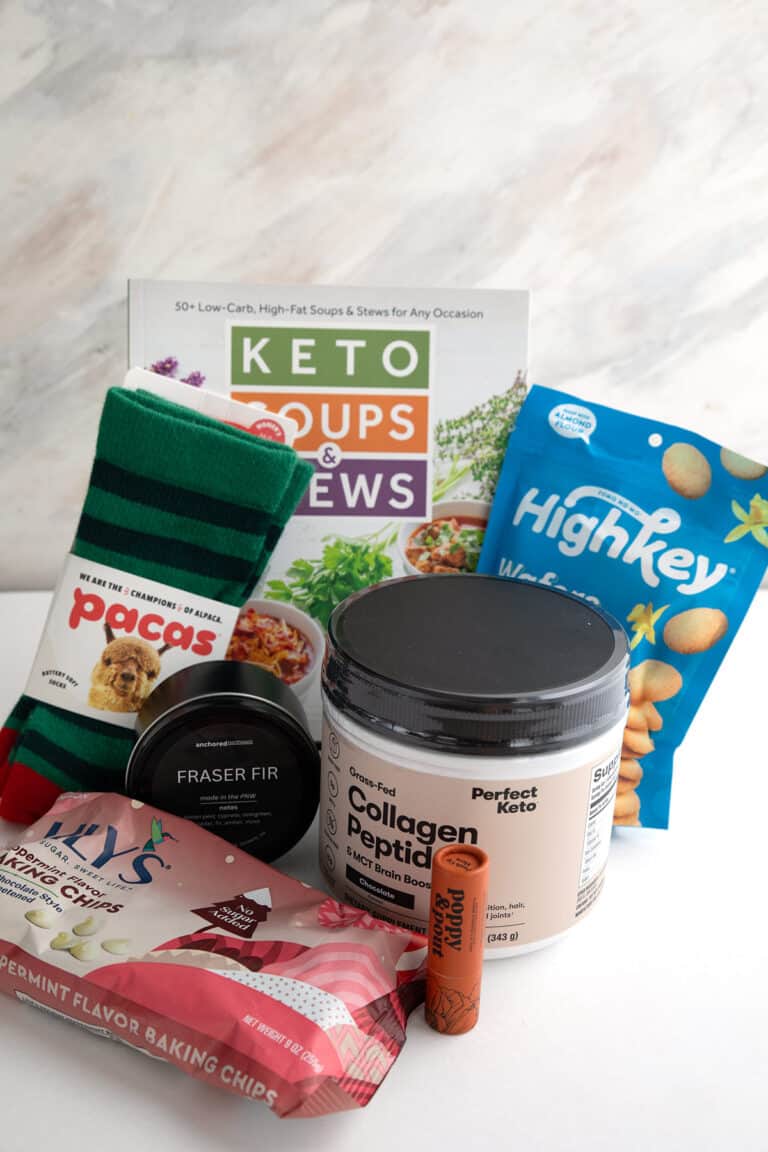











Carolyn, thank you so much for this article. Where I’m still needing some guidance is sub’ ing Pyure brand for Swerve brand in many recipes. I often use both Pyure granular and confectioners sweetener blends as they seem easiest on my guts. I’ve noticed they also have a non-blend of just erythritol that I haven’t yet tried. Your advice on this regarding ratios for substitutions would be great!
Question about Allulose. It shows cars on the nutrition label. Do we disregard those in out carb count for a keto diet or do they count?
Just like erythritol, our bodies don’t treat it like a carb. The article already states this:
Allulose is a relative newcomer on the sugar alternative scene and has become incredibly popular. It is a monosaccharide, which means it really is a “sugar”, but one that our bodies don’t treat like a sugar or a carb. It is largely excreted without ever affecting blood glucose levels.
Thank you so much for all you informed information, fabulous recipes, research & patience. I’m in australia, an older person trying to change my diet due to metabolic disorder. Susanna ????
Thank you. This is immensely helpful
What would you recommend when making whipped cream? I made some the other night, using Swerv Confectioner and it tasted fine BUT it looked curdled the longer it sat although it still tasted okay. I don’t have my baking book to check it out. I used HWC, vanilla and the Swerv. Thanks, Carolyn.
It’s not the Swerve making it curdled. Powdered swerve is what I use EVERY time I make whipped cream. But you can’t let it sit for days after being whipped unless you stabilized it with some gelatin. Any whipped cream will lose fluffiness after sitting and some water will leak out of it if you don’t stabilize it, even ones made with sugar.
That’s a great tip, thanks Carolyn. I will powder my pyure before when making whip cream.
Dear Carolyn,
thank you very much for your lots of work of explaining all this. I am from Germany and the products have other names, but the ingredients are the same. So I will stay using Erythrit, I have a nice mixture Erythrit/Stevia, so it tastes is less cool.
Thank you for your fantastic recipes and please go on with it. I am diabetic and always searching for tasty food – and I am a sweet tooth. I also bought cups for measurement. Thanks web and globalization ????????
Hi! What about sucralose? May I use it to bake keto cakes?
I have GI with erythritol, so I’m looking for alternatives.
Many thanks.
Sucralose is not a natural sweetener so I don’t use it.
What is the best sweetner when making a glaze?
Depends on what kind of glaze we’re talking about.
I really appreciate this breakdown of the alternative sweeteners and how they behave in different applications. Until recently, I’ve just tried winging it by combining different sweeteners to get the flavor profile I wanted without having any idea of how they would affect my baking, sauces, ice creams, etc. Thank you for all of your experimentation and your clear explanations. I love crispy cookies and will always use erythritol sweeteners to get that crunch. And I like scoopable ice cream and will follow your guidance to get creamy results. Thank you!
Thank you for this information but you didn’t mention Pyure. Can you please explain how using this affects baked goods?
THanks!
But it is included… grab your bag of Pyure. Flip it over… what’s the main ingredient? Then reference that main ingredient in this article.
Carolyn, I’m just seeing your reply here, but since I’m using their blends (vs their just erythritol) the sweetness seems off for a 1-1 sub when a receive calls for swerve… Hope I’m explaining well. Thanks
Sweeteners are such a matter of taste that I can’t really guide you. Their packaging should tell you how sweet they are in regards to sugar, but that’s just the average person. If you taste it as more sweet, you need to cut back.
I have a bottle of liquid allulose and am unsure as to how to use it! Thanks!
Well it’s allulose so mostly it will work like allulose BUT… because it’s liquid, it can throw off the liquid content of baked goods. So use it in the same amounts but be prepared to reduce the liquid in things like cakes and muffins.
Is Truvia not considered a keto sugar substitute. Why is it not mentioned?
Please take your bag or box of Truvia and flip it over. What’ the main ingredient? Erythritol. Hence… this article applies to Truvia just as it does to any erythritol based sweetener.
Your recipes are great! They are so easy to follow and practical! Thanks for all you effort!
Sara
A conversion table would be very helpful along with all this great info
There are far too many sweeteners with different formulations for me to do this. There is no clear “conversion” when they all differ so much.
Hi Carolyn,
Thanks for this great information!
I would like to make candied angelica. Here is a recipe for it here:
https://savageandsage.com/2014/07/07/its-seasonal-candied-angelica/comment-page-1/#comment-1841
What type of a sweetener would you recommend I use, and would it have the same preservation qualities of sugar?
Hi Carolyn,
Thank you for all the great information! I’d like to make an old family recipe (cookies); but substitute in the right sweetener(s) here for a friend of mine who is in need of keto. The original recipe calls for both regular white cane sugar as well as brown sugar. What do you suggest I use?
Thank you,
Vicki
Without seeing the full recipe and knowing the texture you are trying to achieve, I really can’t advise.
Hi, I Experience a nasty effect from stevia during baking. The batter tastes so great with stevia (am use it for coffee and chocolates and I find no after taste unless used in very larhe amounts) but when it goes right into oven and comes out, the sweetness all disappears and I am left with only bitter tasting products.
I tried multiple brands, More or less all gave same results. I dont doubt the recipe since I tried them with erythritol and sucralose- they were just great.
The sweetness of stevia just disappears while baking, atleast for me. Do you knoe why ?
Nope, no idea. But as I point out in this article, we all experience these sweeteners differently so this is just you. Why bother with stevia, when there are so many other great all natural sweeteners?
Hi Carolyn. Very informative article. Something i was looking for a longtime. Please can you comment on newest kid on the block – “purecane”. It is made from fermenting sugarcane. Supposed to have Erythritol and Sugarcane reb M. I have tried it. It does not have any aftertaste. But it is not as sweet as sugar. But sweeter than Lakanto ( i ad to use 3 sachets of Lakanto Vs 2 for Purecane). But Reb M is supposed to be 250 times sweeter! So assume it’s concentration is very small in pure cane, mostly it must be Erythritol. I have to guess as they list Reb M as ingredient but do not state it’s concentration.
It would be great to have your expert views on this.
I tried it in some cookies and did not think it baked very well. They were tough but neither crisp nor chewy. Not my favorite!
Do you have an opinion on Glysine as a sweetner?
Never heard of it. Do you have a link?
Thank you soooo much! I’ve bookmarked this page for frequent reference. I’ve had sauces that gelled on me or dressings that stayed grainy (which ones dissolve the best for salad dressings?. I don’t like the taste of allulose except I do use it to candy my pecans for chicken salad. I’m trying xylitol next but I know I’ll have to be very careful because of our dog. Really appreciate the info
What sweetener do you think would work best in recipes that call for sugar that are going to pressure canned or water bath canned.
It’s not about the pressure canner at all… it’s about what you are trying to make with it. If it’s jam or jelly, then I would say BochaSweet or allulose.
What about canning fruit? Which is best please????
Well… if you don’t want it to recrystallize, then use one of the sweeteners that I indicate won’t recrystallize.